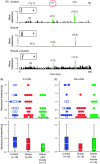Extracranial injections of botulinum neurotoxin type A inhibit intracranial meningeal nociceptors' responses to stimulation of TRPV1 and TRPA1 channels: Are we getting closer to solving this puzzle?
- PMID: 26984967
- PMCID: PMC4959034
- DOI: 10.1177/0333102416636843
Extracranial injections of botulinum neurotoxin type A inhibit intracranial meningeal nociceptors' responses to stimulation of TRPV1 and TRPA1 channels: Are we getting closer to solving this puzzle?
Abstract
Background: Administration of onabotulinumtoxinA (BoNT-A) to peripheral tissues outside the calvaria reduces the number of days chronic migraine patients experience headache. Because the headache phase of a migraine attack, especially those preceded by aura, is thought to involve activation of meningeal nociceptors by endogenous stimuli such as changes in intracranial pressure (i.e. mechanical) or chemical irritants that appear in the meninges as a result of a yet-to-be-discovered sequence of molecular/cellular events triggered by the aura, we sought to determine whether extracranial injections of BoNT-A alter the chemosensitivity of meningeal nociceptors to stimulation of their intracranial receptive fields.
Material and methods: Using electrophysiological techniques, we identified 161 C- and 135 Aδ-meningeal nociceptors in rats and determined their mechanical response threshold and responsiveness to chemical stimulation of their dural receptive fields with TRPV1 and TRPA1 agonists seven days after BoNT-A administration to different extracranial sites. Two paradigms were compared: distribution of 5 U BoNT-A to the lambdoid and sagittal sutures alone, and 1.25 U to the sutures and 3.75 U to the temporalis and trapezius muscles.
Results: Seven days after it was administered to tissues outside the calvaria, BoNT-A inhibited responses of C-type meningeal nociceptors to stimulation of their intracranial dural receptive fields with the TRPV1 agonist capsaicin and the TRPA1 agonist mustard oil. BoNT-A inhibition of responses to capsaicin was more effective when the entire dose was injected along the suture lines than when it was injected into muscles and sutures. As in our previous study, BoNT-A had no effect on non-noxious mechanosensitivity of C-fibers or on responsiveness of Aδ-fibers to mechanical and chemical stimulation.
Discussion: This study demonstrates that extracranial administration of BoNT-A suppresses meningeal nociceptors' responses to stimulation of their intracranial dural receptive fields with capsaicin and mustard oil. The findings suggest that surface expression of TRPV1 and TRPA1 channels in dural nerve endings of meningeal nociceptors is reduced seven days after extracranial administration of BoNT-A. In the context of chronic migraine, reduced sensitivity to molecules that activate meningeal nociceptors through the TRPV1 and TRPA1 channels can be important for BoNT-A's ability to act as a prophylactic.
Keywords: Headache; chronic migraine; migraine prophylaxis; pain; trigeminovascular.
© International Headache Society 2016.
Figures




Similar articles
-
Selective inhibition of meningeal nociceptors by botulinum neurotoxin type A: therapeutic implications for migraine and other pains.Cephalalgia. 2014 Oct;34(11):853-69. doi: 10.1177/0333102414527648. Epub 2014 Apr 2. Cephalalgia. 2014. PMID: 24694964 Free PMC article.
-
Exploring the effects of extracranial injections of botulinum toxin type A on prolonged intracranial meningeal nociceptors responses to cortical spreading depression in female rats.Cephalalgia. 2019 Oct;39(11):1358-1365. doi: 10.1177/0333102419873675. Epub 2019 Aug 31. Cephalalgia. 2019. PMID: 31475573 Free PMC article.
-
Activation of TRPV1 and TRPA1 leads to muscle nociception and mechanical hyperalgesia.Pain. 2009 Aug;144(3):270-277. doi: 10.1016/j.pain.2009.04.021. Epub 2009 May 22. Pain. 2009. PMID: 19464796 Free PMC article.
-
Extracranial origin of headache.Curr Opin Neurol. 2017 Jun;30(3):263-271. doi: 10.1097/WCO.0000000000000437. Curr Opin Neurol. 2017. PMID: 28248698 Free PMC article. Review.
-
Differential effects of TRPV channel block on polymodal activation of rat cutaneous nociceptors in vitro.Exp Brain Res. 2009 Jun;196(1):31-44. doi: 10.1007/s00221-009-1808-3. Epub 2009 Apr 30. Exp Brain Res. 2009. PMID: 19404626 Review.
Cited by
-
Mechanism of Action of OnabotulinumtoxinA in Chronic Migraine: A Narrative Review.Headache. 2020 Jul;60(7):1259-1272. doi: 10.1111/head.13849. Epub 2020 Jun 30. Headache. 2020. PMID: 32602955 Free PMC article. Review.
-
Plasma Levels of Oxidative Stress Markers, before and after BoNT/A Treatment, in Chronic Migraine.Toxins (Basel). 2019 Oct 19;11(10):608. doi: 10.3390/toxins11100608. Toxins (Basel). 2019. PMID: 31635021 Free PMC article. Clinical Trial.
-
The association between onabotulinumtoxinA and anti-CGRP monoclonal antibodies: a reliable option for the optimal treatment of chronic migraine.Neurol Sci. 2022 Sep;43(9):5687-5695. doi: 10.1007/s10072-022-06195-5. Epub 2022 Jun 10. Neurol Sci. 2022. PMID: 35680766 Review.
-
Neurogenic inflammation and its role in migraine.Semin Immunopathol. 2018 May;40(3):301-314. doi: 10.1007/s00281-018-0676-y. Epub 2018 Mar 22. Semin Immunopathol. 2018. PMID: 29568973 Review.
-
Synergism of Anti-CGRP Monoclonal Antibodies and OnabotulinumtoxinA in the Treatment of Chronic Migraine: A Real-World Retrospective Chart Review.CNS Drugs. 2024 Jun;38(6):481-491. doi: 10.1007/s40263-024-01086-z. Epub 2024 Apr 7. CNS Drugs. 2024. PMID: 38583127 Free PMC article.
References
-
- Aurora SK, Dodick DW, Turkel CC, et al. OnabotulinumtoxinA for treatment of chronic migraine: Results from the double-blind, randomized, placebo-controlled phase of the PREEMPT 1 trial. Cephalalgia 2010; 30: 793–803. - PubMed
-
- Diener HC, Dodick DW, Aurora SK, et al. OnabotulinumtoxinA for treatment of chronic migraine: Results from the double-blind, randomized, placebo-controlled phase of the PREEMPT 2 trial. Cephalalgia 2010; 30: 804–814. - PubMed
-
- Bolay H, Reuter U, Dunn AK, et al. Intrinsic brain activity triggers trigeminal meningeal afferents in a migraine model. Nat Med 2002; 8: 136–142. - PubMed
-
- Noseda R, Burstein R. Migraine pathophysiology: Anatomy of the trigeminovascular pathway and associated neurological symptoms, cortical spreading depression, sensitization, and modulation of pain. Pain 2013; 154(Suppl 1): S44–S53. - PubMed
MeSH terms
Substances
LinkOut - more resources
Full Text Sources
Other Literature Sources
Medical
Research Materials
Miscellaneous

